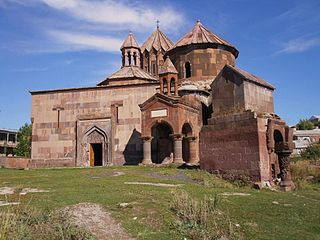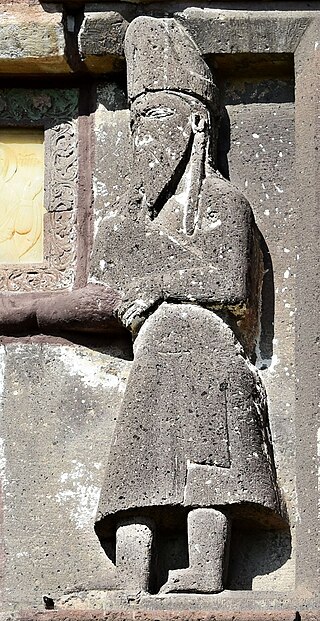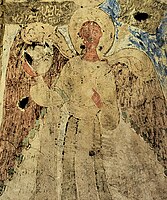
Geghard is a medieval monastery in the Kotayk province of Armenia, being partially carved out of the adjacent mountain, surrounded by cliffs. It is listed as a UNESCO World Heritage Site with enhanced protection status.

Haghartsin, also Hałarcin Monastery, is a 13th-century monastery located near the town of Dilijan in the Tavush Province of Armenia. It was built between the 10th and 13th centuries ; much of it under the patronage of the Bagratuni dynasty.

The Zakarid dynasty, also Zakarids or Zakarians were a noble Armenian dynasty, rulers of Zakarid Armenia (1201–1350) under the suzerainty of the Kingdom of Georgia, and from 1256 under the control of the Mongol Ilkhanate of Persia. Their dynastic name was formed in honour of Zakare, the famous servant of the Georgian Queen Tamar. They were also known by their Georgian nickname Mkhargrdzeli. A family legend says that this name was a reference to their Achaemenid ancestor Artaxerxes II the "Longarmed". According to Cyril Toumanoff / Encyclopædia Iranica, they were an offshoot of the Armenian Pahlavuni family. The Zakarians considered themselves Armenians.

Ani is a ruined medieval Armenian city now situated in Turkey's province of Kars, next to the closed border with Armenia.

The Harichavank is 7th century Armenian monastery located near the village of Harich in the Shirak Province of Armenia. The village is 3 km southeast of the town of Artik.

Armenian architecture comprises architectural works with an aesthetic or historical connection to the Armenian people. It is difficult to situate this architectural style within precise geographical or chronological limits, but many of its monuments were created in the regions of historical Armenia, the Armenian Highlands. The greatest achievement of Armenian architecture is generally agreed to be its medieval churches and seventh century churches, though there are different opinions precisely in which respects.

Kobayr is a 12th-century Armenian monastery located in the village Kobayr, directly across the road from the town of Tumanyan, within Lori marz, Armenia.

Horomos, also known as Horomosivank or Ghoshavank, is an abandoned and ruined medieval Armenian monastic complex about 15 kilometers northeast of the ruins of Ani in present-day eastern Turkey. With its collection of churches, chapels and tombs, Horomos has been described as one of the most significant spiritual and cultural religious centers in medieval Armenia and one of the largest in all the Christian East.

Sanahin Monastery is an Armenian monastery founded in the 10th century in Sanahin in the Lori Province of Armenia.

Zakarid Armenia alternatively known as the Zakarid Period, describes a historical period in the Middle Ages during which the Armenian vassals of the Kingdom of Georgia were ruled by the Zakarid-Mkhargrzeli dynasty. The city of Ani was the capital of the princedom. The Zakarids were vassals to the Bagrationi dynasty in Georgia, but frequently acted independently and at times titled themselves as kings. In 1236, they fell under the rule of the Mongol Empire as a vassal state with local autonomy.

Zakare II Zakarian or Zakaria II Mkhargrdzeli, was an Armenian prince of Christianized Kurdish origin, and a Court official of the Kingdom of Georgia holding the office of amirspasalar (Commander-in-Chief) of the Georgian army for Queen Tamar of Georgia, during the late 12th and early 13th centuries. He was a member of the Zakarid dynasty, and ruler of feudal lands in the Kingdom of Georgia.
Avag Zakarian was an Armenian noble of the Zakarid line, and a Court official of the Kingdom of Georgia, as atabeg and amirspasalar of Georgia from 1227 to 1250.

Zakare III Zakarian or Zakaria III Mkhargrdzeli was a 13th century Armenian noble and a Court official of the Kingdom of Georgia, holding the position of amirspasalar (Commander-in-Chief) for the Georgian army.

Menucihr Mosque, also Manučehr Mosque is a mosque in the medieval city of Ani in Kars Province, Turkey. It was built between 1072 and 1086 by Manuchihr ibn Shavur of the Kurdish Shaddadid dynasty. The restoration of the mosque started in June 2020.

Ivane I Zakarian was an Armenian prince of Christianized Kurdish origin, and a Court official of the Kingdom of Georgia holding the offices of Msakhurtukhutsesi (Majordomo) and Atabeg for Queen Tamar of Georgia during the early 13th centuries. He was a prince of the Zakarid dynasty, the son of Sargis Zakarian, and the younger brother and successor of Zakare II Zakarian. He was also ruler of feudal lands in the Kingdom of Georgia.

Shahnshah Zakarian was a member of the Armenian Zakarid dynasty, and a Court official of the Kingdom of Georgia, holding the office of amirspasalar (Commander-in-Chief) of the Georgian army. He was the son of Zakare II Zakarian, and the father of Zakare III Zakarian, who participated to the Siege of Baghdad in 1258.

The Church of St Gregory of Tigran Honents, or Church of Saint Gregory the Illuminator in Ani, in Turkey's province of Kars next to the closed border with Armenia, was built by the Armenian Tigran Honents under the Zakarids in 1215, according to an inscription in Armenian on the exterior of the church.

The Church of Saint Elia also Zakare's church, is located in Kizkale, near Ani in Turkey. It was built by the Zakarids in the early 13th century, as well as the nearby church of Tigran Honents.

The Church of the Holy Apostles, also Surp Arak’elots, is an important ecclesiastical monument of the ruined city of Ani, modern Turkey, on the border with Armenia.
Shahnshah II Zakarian was a member of the Armenian Zakarid dynasty, and a Court official of the Kingdom of Georgia, holding the office of amirspasalar (Commander-in-Chief) and atabeg of Georgia.






















